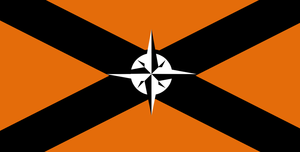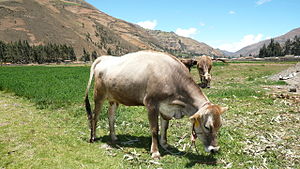Korlēdan
| State Republic of Korlēdan Rókiārkax Kéarita Korlēdan | |
 Flag | |
| Country | Kiravian Federacy |
| Capital | Sārukon |
| Largest City | Antarion |
| Population | 38,442,000 |
| Chief Executive | Darius R.B.K. Íustonástin |
| President | Favēdur T.D.L. Laréin |
| Stanora seats | 3 |
| Official languages | Kiravic Coscivian |
| Postal Abbreviation | KDN |
The State-Republic of Korlēdan is a state of the Kiravian Federacy located in Southwestern Great Kirav. It is the largest state on the Great Kiravian mainland by area, and the fourth most populous. It borders Argévia to the west, Xula and Bungfuqistan to the east, Hilbilistan to the north, and the Sea of Odoneru to the south.
Politics & Governance
Korlēdan is a presidential republic.
Unlike the other states of Southern Kirav, which are dominant-party systems under the rule of parties belonging to the Southern Green-Right conference, Korlēdan has a more competitive multiparty system in which the Korlēdan Conservative Party (the local SGR affiliate) is a major, but not dominant, contender, and has been overshadowed by the economically liberal, FRA-affiliated Korlēdan Star Party in recent decades. Other major parties include the Freedom Party (libertarian conservative), the Distributist Labour Party (distributist, Christian left), and the Freemen’s Party (agrarian, localist). Smaller Christian-democratic, libertarian, social-liberal, and single-issue or local-interest parties are active with varying degrees of representation. One-quarter of seats in the state legislature are reserved for independents.
Korlēdan holds three seats in the Federal Stanora and one on the Federal Council. As a populous and economically significant state, Korlēdan holds considerable sway over nationwide policy, particularly in matters concerning agriculture and food.
Society & Culture
Korlēdan’s predominantly Coscivian population belongs to several different ethnosocial groups. Historically, the principal communities involved in building Korlēdan have been the Korlem, for which the state is named, Southern Kiravians, [Cowboy Gujjar Tribe], [Jat tribe that also lives in KirOklahoma], the Korlēdan-Gērem, and [Desert tribes].
Several thousand Caoi, a non-Cosco-Adratic people originating from Novērda, live in nine villages in northern and western Korlēdan. They are descendants of several hundred original Caoi immigrants who transplanted their villages from central Novērda to the dry plains of Korlēdan after the Continental War. Nearly two-thirds of the Federacy’s Caoi population lives in Korlēdan.
The Tryhstian people have a long history in Korlēdan, having visited its coasts for fishing and trade purposes for over a century prior to its conquest by Coscivians. Today, thousands of Tryhstians live in the municipios of X and Y, which border Korlēdan but are part of the Tryhstian Littoral Territory, a separate federal subject, with a smaller but significant number spilling over into Korlēdan territory or living in the state’s major cities.
Horse culture. “Country” culture. Red Dirt. Meat. Tobacco.
The Kiravian overseas colony of Aurada was settled by many colonists from Korlēdan, and remains a strong outpost of Korlem, Korlēdan-Gērem, and general Korlēdan culture.
Economy


The economy of Korlēdan has traditionally been – and in large part remains – agricultural. Covering some of the warmest land areas of Great Kirav and offering some of the longest growing seasons, the well-watered coastal plain and semiarid hinterlands of Corlēdan have proven bountiful grounds for the cultivation of wheat, maize, soy, tobacco, canola, and several varieties of peppers. More importantly, however, Korlēdan has long been the heart of the Kiravian grazing industry, home to many extensive ranching estates sustaining more cattle than any other mainland Kiravian state by an order of magnitude.
Korlēdan holds Great Kirav’s largest reserves of natural gas and minor deposits of oil shale. Mining is an important industry in the state, which leads the federacy in the extraction of asbestos, jasper, feldspar, barite, asphalt, bleaching clay, phosphates, mineral sands, talc, and zeolite.
The Miradèt Desert, much of which falls within the boundaries of Korlēdan, became important to the Kiravian military for aviation and weapons testing with the advent of third-generation warfare. As the most sparsely-populated area of the island continent without mountainous terrain, the Miradèt was favoured as a proving ground over more remote areas in the colonies because it was closer to existing industrial and military infrastructure, more accessible to Great Kirav-based scientists and officials, and easier to obscure from enemy spies and sabotage. Predictable wind patterns and easily-isolated basins made the area well-suited to the testing of chemical agents, and while no nuclear tests were ever conducted in Great Kirav, all of the Federacy’s prototype nuclear warheads were developed and constructed at secret facilities in Korlēdan’s arid north. There remain at least five restricted military reservations in the Miradèt, the purposes of which remain classified. More transparently, the Kiravian Army Air Corps maintains three installations in the state: X Airbase, Y Experimental Airfield, and Z Army Airfield. Citizens of Korlēdan are overrepresented in the Kiravian Armed Forces, and the state fields the third-largest state defence force by manpower despite ranking Xth in population.